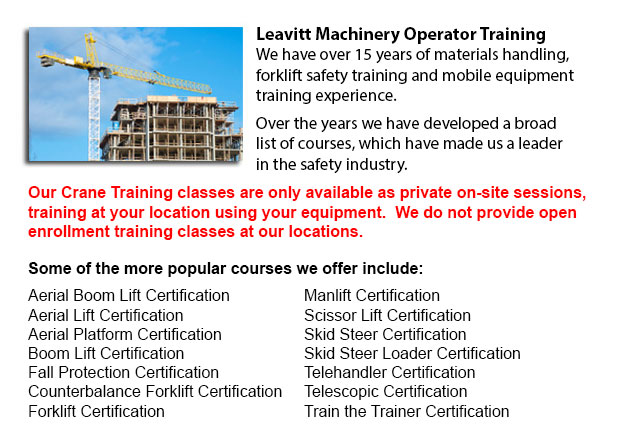
Overhead Crane Safety Training Fort Mcmurray - Overhead crane safety training equips operators with skills and knowledge regarding crane safety precautions, accident avoidance, materials handling, and equipment and stock protection. Trainees will learn the types of overhead cranes, their capabilities and their uses in various industry settings. For operators who are licensed and trained, the shift in liability moves to the operator from the company. Therefore, the program emphasizes individual operator tasks.
Overhead crane safety training instructs operators in the correct techniques for carrying out inspections. Two kinds of pre-shift inspection are the walk-around inspection and the in-depth inspection. These are important every day routines which should be logged. Correctly recorded pre-shift checks help to protect the company from liability in the event of an accident. Pre-shift checks also prevent accidents, damage and costly repairs. Operators learn how to designate a specific individual to carry out checks, how to report problems, and how to maintain the log book.
Each inspection should be documented and carried out regularly. Things that must be inspected for possible concerns, include: hooks for cracks, increases in the throat opening, degree of twist; hoist ropes for corrosion, loss of diameter, worn wires, broken wires, bird caging and kinks, chains for gouges and nicks, chemical and heat damage, twists, cracks and corrosion, distortion, excessive wear, pits, stretching, damage caused by extreme heat.
The operator will get to learn the correct methods regarding proper rigging procedures. The process of rigging includes the understanding of the manufacturer's data plate, determining the material weight to be lifted, selecting the gear, and using safe practices to secure the load. The program include in detail the following: safe working loads, and the capacities of ropes, chains, hooks, shackles and slings.
It is vital to understand who may use the cranes at your facility, the job's physical requirements, and operator credentials needed for specialized job and permits. Safety is a top priority when utilizing near pedestrian traffic.
The responsibilities included in the safe crane operation includes undertaking visual inspections, checking for hydraulic leaks, checking the safety guards, testing the controls, examining the hook and hoist rope, limit switches and braking mechanisms. Proper reporting methods are vital. These topics are all included in depth in the program.
The course likewise consists of the correct moving and lifting procedures with hoists and cranes. Operators would also learn correct hand signals. Training involves how to raise the load, attach the load, unhook the slings, abort a lift and set the load.
Moving the load includes several steps: stopping and starting procedures, guiding and controlling the load, observing working conditions and working with signals. Operators must know how to proceed in the event of a power failure. The program covers methods for lowering the load and removing the slings, parking the crane, storage equipment, and securing an outdoor and indoor crane.
-
Telehandler Training Fort Mcmurray
Telehandler Training Fort Mcmurray - Telehandlers or also called Telescopic handlers are very popular piece of heavy construction equipment most often utilized in agriculture and construction industries. These machines have extreme reaching capabilit... More -
Counterbalance Forklift Training Fort Mcmurray
Counterbalance Forklift Training Fort Mcmurray - Counterbalance Forklift Training courses are always in high demand. The Counterbalance forklift is a forklift that is made along with a weight that counters the balance, evenly spreading the weight of... More -
Heavy Equipment Training School Fort Mcmurray
Heavy Equipment Training School Fort Mcmurray - HEO or the heavy equipment operator courses will provide you with the knowledge and skills required in order to enter the workforce as an entry level heavy machine operator. In this 12 week course in ad... More -
Operator Safety Training, Re-Qualification Training, In-House Instructor Training in Fort McMurray
Used in just about all boat yards, industrial construction sites or warehouse operations, the forklift is a very important component in order to help pick up and transfer supplies. The reach feature of a lift truck could help improve the applications... More -
Heavy Equipment License Fort Mcmurray
Heavy Equipment License Fort Mcmurray - A heavy equipment license can be obtained by finishing a certification and preparation course at a private training school or a vocational school. This license would qualify you to operate various types of heav... More -
Boom Lift License Fort Mcmurray
Boom Lift License Fort Mcmurray - To operate an aerial boom lift, operators must be licensed through training that can be obtained utilizing both practical training and classroom sessions and by obtaining a boom lift license. Instruction must be give... More -
Skid Steer Loader Training in Fort McMurray
A skid-steer loader is actually an engine powered machine that consists of a small and rigid frame. It is outfitted along with lift arms which are used to attach to different labor saving attachments and tools. Normally, skid-steer loaders are four-w... More -
Order Picker Ticket Fort Mcmurray
Order Picker Ticket Fort Mcmurray - Order picker's enables warehouse employees to lift pallets using forks. Likewise called a stock picker, this electrically-powered equipment is like a forklift except that an order picker is likewise utilized to lif... More

Forklift Training Fort McMurray
TOLL FREE: 1-888-254-6157
Fort McMurray, Alberta
forklifttrainingfortmcmurray.com
Email Us
About Us


